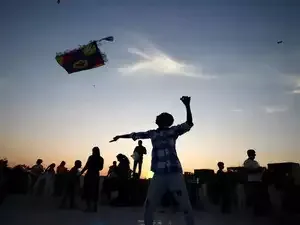The festival of Makar Sankranti is celebrated every year on January 14, except in the leap year when it falls on January 15.
The festival marks the sun's transition into the zodiac sign of Capricorn (Makara), signifying the start of the Sun's northward journey. It is considered an auspicious time, symbolising positivity and new beginnings. The festival is celebrated with joy and enthusiasm.
There are several stories behind the festival, including one where Lord Shani and Lord Surya made peace, symbolising balance.
Another story is about King Bhagiratha, who brought the Ganges River to Earth to purify his ancestors, symbolising cleansing and fresh beginnings.
The festival is a time for renewal, expressing gratitude, and celebrating the bounties of life. Further, it marks the start of a new agricultural cycle, making it a time to offer thanks for the harvest and pray for prosperity in the year ahead.
In North India, it is known as Lohri, where people gather around bonfires, singing folk songs, dancing, and feasting to celebrate the harvest season.
In South India, the festival is celebrated as Pongal. The celebration can go on for several days. People prepare a special dish called Pongal and offer thanks for the harvest.
In West India, especially in Gujarat and Rajasthan, kite flying is the highlight of the celebration. People take to rooftops to fly colourful kites in honour of the Sun's northward journey
In East India, particularly in West Bengal, the Ganga Sagar Mela is held. Devotees take a holy dip at the confluence of the Ganga and the Bay of Bengal, symbolising purification and renewal.
ET Year-end Special Reads
Buying a home in 2025? Here's how property market can shape up
18 top stock picks for 2025 from 6 leading brokers
Five big bangs that shook the corporate world in 2024
Makara Sankranti 2025: Time
Makar Sankranti Moment: 09:03 AM, January 14, 2025.Makara Sankranti 2025: History
Makar Sankranti is the end of the winter season and the start of a new farming cycle. This day is celebrated to thank nature for the harvest and pray for good luck in the coming year.There are several stories behind the festival, including one where Lord Shani and Lord Surya made peace, symbolising balance.
Another story is about King Bhagiratha, who brought the Ganges River to Earth to purify his ancestors, symbolising cleansing and fresh beginnings.
Makar Sankranti 2025: Significance
Makar Sankranti is important not just from an astronomical and mythological perspective, but also symbolises the triumph of light over darkness, good over evil, and hope over despair.The festival is a time for renewal, expressing gratitude, and celebrating the bounties of life. Further, it marks the start of a new agricultural cycle, making it a time to offer thanks for the harvest and pray for prosperity in the year ahead.
Makar Sankranti 2025: Rituals
Makar Sankranti is celebrated across India with unique rituals in different regions:In North India, it is known as Lohri, where people gather around bonfires, singing folk songs, dancing, and feasting to celebrate the harvest season.
In South India, the festival is celebrated as Pongal. The celebration can go on for several days. People prepare a special dish called Pongal and offer thanks for the harvest.
In West India, especially in Gujarat and Rajasthan, kite flying is the highlight of the celebration. People take to rooftops to fly colourful kites in honour of the Sun's northward journey
In East India, particularly in West Bengal, the Ganga Sagar Mela is held. Devotees take a holy dip at the confluence of the Ganga and the Bay of Bengal, symbolising purification and renewal.








